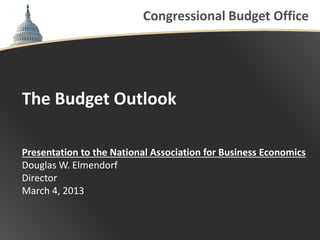
The Budget Outlook
- 1. Congressional Budget Office The Budget Outlook Presentation to the National Association for Business Economics Douglas W. Elmendorf Director March 4, 2013
- 2. Topics to Cover The Budget Outlook Consequences of High and Rising Federal Debt Criteria for Evaluating Possible Courses of Action CONGRESSIONAL BUDGET OFFICE
- 3. How Big Are Projected Federal Deficits and Debt? CONGRESSIONAL BUDGET OFFICE
- 4. Total Federal Deficits or Surpluses (Percentage of GDP) Estimates from The Budget and Economic Outlook: Fiscal Years 2013 to 2023 (February 2013). CONGRESSIONAL BUDGET OFFICE
- 5. Total Federal Revenues and Outlays (Percentage of GDP) Estimates from The Budget and Economic Outlook: Fiscal Years 2013 to 2023 (February 2013). CONGRESSIONAL BUDGET OFFICE
- 6. Projected Growth in Major Federal Spending Categories (Percentage of GDP) Estimates from The Budget and Economic Outlook: Fiscal Years 2013 to 2023 (February 2013). CONGRESSIONAL BUDGET OFFICE
- 7. Federal Debt Held by the Public (Percentage of GDP) Actual Projected Estimates from The Budget and Economic Outlook: Fiscal Years 2013 to 2023 (February 2013). CONGRESSIONAL BUDGET OFFICE
- 8. What Are the Consequences of High and Rising Federal Debt? CONGRESSIONAL BUDGET OFFICE
- 9. High and Rising Debt Relative to the Size of the Economy Is A Significant Concern for Several Reasons First: Crowding out of capital investment will be greater. Second: Lawmakers will have less flexibility to respond to unexpected challenges. Third: There will be a heightened risk of a fiscal crisis. CONGRESSIONAL BUDGET OFFICE
- 10. Fourth: Debt Would Be Even Larger If… …Current laws were modified to delay or undo certain scheduled changes in policy. For example, if lawmakers: Eliminated the automatic spending cuts that have just taken effect; Extended all of the tax provisions that are scheduled to expire; Prevented the reduction in Medicare’s payment rates for physicians scheduled for next January; and Made no other policy changes with offsetting budget effects... Then, debt would rise to 87 percent of GDP by 2023. CONGRESSIONAL BUDGET OFFICE
- 11. Fifth: Original Caps on Discretionary Funding Are Very Low Relative to GDP (Percentage of GDP) 7 Actual Projected 6 Defense Spending 5 4 3 Nondefense Spending 2 1 0 1973 1978 1983 1988 1993 1998 2003 2008 2013 2018 2023 Estimates from The Budget and Economic Outlook: Fiscal Years 2013 to 2023 (February 2013). Estimates incorporate the assumption that the automatic spending reductions required by the Budget Control Act do not take effect, although the original caps on discretionary appropriations remain in place and are met through proportional reductions in defense and nondefense budget authority. CONGRESSIONAL BUDGET OFFICE
- 12. Sixth: 10-Year Projections Do Not Fully Reflect Long-Term Budget Pressures Health (Percentage of GDP) 15 Actual Projected 10 Medicaid and Other 5 Medicare 0 2000 2005 2010 2015 2020 2025 2030 2035 Social Security 15 10 5 0 2000 2005 2010 2015 2020 2025 2030 2035 Estimates from The 2012 Long-Term Budget Outlook (June 2012). CONGRESSIONAL BUDGET OFFICE
- 13. What Are Some Criteria for Evaluating Proposed Policy Changes? CONGRESSIONAL BUDGET OFFICE
- 14. Criterion #1: How Much Would Debt Be Reduced? The more that debt is reduced, the more that the harms caused by high debt would be avoided—but also the greater the loss of government benefits and services or the burdens on individuals and businesses of higher taxes. CONGRESSIONAL BUDGET OFFICE
- 15. Debt Held by the Public Under Current Law and Alternative Budgetary Paths (Percentage of GDP) 90 $2 Trillion Increase in Primary Deficits 80 CBO's Baseline (Current law) $2 Trillion Reduction in 70 Primary Deficits 60 $4 Trillion Reduction in Primary Deficits 50 0 2013 2014 2015 2016 2017 2018 2019 2020 2021 2022 2023 Estimates from Macroeconomic Effects of Alternative Budgetary Paths (February 2013). CONGRESSIONAL BUDGET OFFICE
- 16. Criterion #2: How Quickly Would Debt Be Reduced? The sooner deficits are cut, the less debt that will be accumulated—but also the greater the drag on economic activity over the next few years. Indeed, several provisions of current law that are bringing down the deficit will weaken output and employment this year. CONGRESSIONAL BUDGET OFFICE
- 17. Unemployment Rate (Percent) Estimates from The Budget and Economic Outlook: Fiscal Years 2013 to 2023 (February 2013). CONGRESSIONAL BUDGET OFFICE
- 18. Criterion 3: How Would the Government’s Resources Be Allocated? (Percentage of GDP) Estimates from The Budget and Economic Outlook: Fiscal Years 2013 to 2023 (February 2013). CONGRESSIONAL BUDGET OFFICE
- 19. Criterion #4: How Would Policy Changes Affect Longer- Term Economic Performance? Possible effects of: Raising marginal tax rates on labor; Raising marginal tax rates on capital; Cutting government benefits; and Reducing government investment. CONGRESSIONAL BUDGET OFFICE
- 20. Criterion #5: Who Would Bear the Burden of Policy Changes? Possible effects on: Distribution of burden among people at different income levels; Distribution of burden among people with similar income but other differences; and Distribution of burden among people in different generations. CONGRESSIONAL BUDGET OFFICE
- 21. Key Implication of CBO’s Budget Projections Putting the debt on a sustainable path will ultimately require increases in taxes or cuts in government benefits or services for people who consider themselves to be in the middle class. CONGRESSIONAL BUDGET OFFICE
